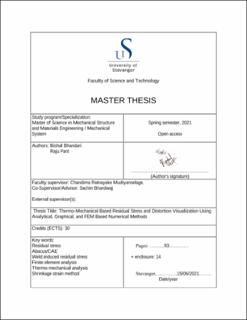| dc.description.abstract | The arc welding process is the main fusion welding process used in the offshore industry. This thesis attempts to understand the residual stress and distortion issues attributed to welding, and the study aims to bring a sense of value, purpose, and relevancy to academic scholarship and industrial application. Welding-induced residual stresses and distortions are prevalent in welded structures. Therefore, understanding the basic principles and theories behind the measurement of residual stress and distortion is the key to solving the issue attributed to welding. This thesis presents an overview of the welding process used in the offshore industry, general weld metallurgy, a brief introduction to the issue, and a short overview of experimental, analytical, and finite element based residual stress and distortion measurement techniques.
Residual stress and distortion issues are discussed in the simplest yet efficient way using one-bar and a three-bar model. Demonstration of longitudinal and transverse residual stress and distortions using the one-bar and three-bar model is the simplest way to visualize the inherent problem of welding.
Thermo-mechanical-based finite element analysis is performed to analyze the 2D axisymmetric plate when the prescribed temperature field is applied to the simplified quarter plate model using ABAQUS software. The result obtained from thermo-mechanical simulation is compared with the result obtained from the shrinkage strain method.
Yield level tensile residual was found along the welding centerline at the end of the heating cycle, causing a longitudinal expansion along the welding axis. At the end of the cooling process, the compressive residual of yield stress magnitude was obtained, which caused longitudinal shrinkage along the welding centerline. The shrinkage strain method showed an approximate result to that of the thermo-mechanical simulation for the case of residual stresses and shrinkage along the welding centerline. A component of transverse residual stress across the welding plate is one-fourth of the yield stress value; however, another component of stresses across the welding centerline observed was nominal. The lateral expansion was observed by thermo-mechanical simulation contrary to the transverse shrinkage observed in the shrinkage strain method. | |
